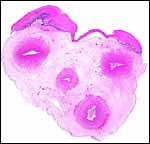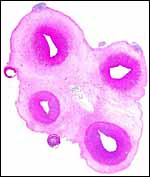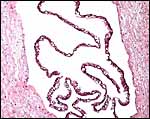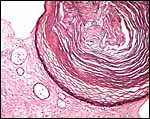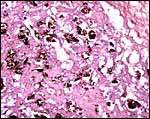| (Clicking
on the thumbnail images will launch a new window and a larger version
of the thumbnail.) |
| Last updated: Oct 26, 2006. |
Cephalorhynchus commersonii
Order: Cetacea
Family: Delphinidae
1) General Zoological Data
This is one of four or five species of this southern Pacific or Piebald dolphins (Wilson & Reeder, 1992). The animals studied here come from the coast of Chile and were bred at Sea World, San Diego . This was the second live birth at Sea World whose placenta was donated by Dr. L. Cornell. The adult weight is up to 80 kg, according to Nowak (1999). Weigl (2006) lists the species to live at least up to 25 years and 9 months in an aquarium. Much additional information is available from that facility (Gewalt, 1979; see also Spotte et al., 1979). Pichler et al. (2001) studied the evolution of these dolphins with mtDNA control regions analysis and concluded that Cephalorhynchus originated in the waters of South Africa and speciated along the western and eastern coasts of South America and are monophyletic. The name derives from kephale=head, rhunkhos=snout according to Gotch (1979), and P. Commerson (1727-1773), a naturalist.
 |
Commerson's dolphins at Sea World, San Diego. |
2) General Gestational Data
This is a typical cetacean placenta, very thin and diffusely covered with short villi. It is epitheliochorial in structure and has a lateral insertion of the umbilical cord. The placenta weighed 610 g. I have unfortunately only B&W pictures available of the gross morphology. Gestation lasts about 12 months and newborns weigh 4.5-7.5 kg (Nowak, 1999). They are delivered in the summer.
3) Implantation
This has not been studied.
4) General Characterization of the Placenta
This epithelio-chorial placenta is completely covered with villi; it is very thin and essentially similar to that of all other cetacean listed here.
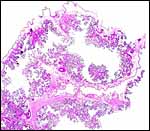 |
This is a cross section of the very thin, villous placenta with amnion and chorion above. |
5) Details of fetal/maternal barrier
The ‘barrier' is typically epithelio-chorial but no implanted specimen has yet been observed.
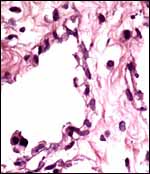 |
The trophoblast is single-layered and cuboidal but necessarily autolyzed because of having to retrieve the placenta from the tank after birth. |
6) Umbilical cord
The umbilical cord was 35 cm long, minimally spiraled, and 2 cm in thickness. It was covered with numerous ‘callosities' composed of thick squamous, keratinized plaques. Some of these callosities are pigmented black. There are 4 large fetal blood vessels and a large allantoic duct.
7) Uteroplacental circulation
There is no information.
8) Extraplacental membranes
There is no decidua in the delivered placenta. The amnion is avascular. Small vessels were found in the allantoic membrane.
9) Trophoblast external to barrier
This has not been studied as no implanted placenta has been available.
10) Endometrium
No implanted placenta or uterus has been observed. In analogy with other cetacean species, however, decidualization is unlikely.
11) Various features
There is no evidence for endometrial invasion by trophoblast.
12) Endocrinology
No data are available.
13) Genetics
Dillon & Wright (1993) examined the D-loop region of a sperm whale and compared the result with those of four other cetacean, including Commerson's dolphin. There was little variation.
14) Immunology
There is no information.
15) Pathological features
Dunn et al. (1982) reported on candidiasis in bottlenose dolphin, a beluga whale, pilot whale and harbor porpoise; despite being in the same tank with infected other species, a Commerson's dolphin did not become infected. Beron-Vera et al. (2001) examined the intestinal tracts of 9 animals caught in nets and 23 animals that had stranded in South America . They found 267 parasites and describe in some detail the nature of these parasites.
16) Physiologic data
I have not found any information.
17) Other resources
No cell lines are available.
18) Other remarks – What additional Information is needed?
Implanted placentas, information on endocrine and reproductive features are needed.
Acknowledgement
The animal photograph in this chapter was taken at Sea World, San Diego . I am grateful to Dr. Lanny Cornell for giving me this placenta.
References
Beron-Vera, B., Pedraza, S.N., Raga, J.A., Dil de Pertierra, A., Crespo, E.A., Alonso, M.K. and Goodall, R.N.P.: Gastrointestinal helminthes of Commerson's dolphins Cephalorhynchus commersonii from central Patagonia and Tierra del Fuego . Dis. Aquat. Organ. 47:201-208, 2001.
Dillon, M.C. and Wright, J.M.: Nucleotide sequence of the D-loop region of the sperm whale (Physeter macrocephalus) mitochondrial genome. Mol. Biol. Evol. 10:296-305, 1993.
Dunn, J.L., Buck, J.D. and Spotte, S.: Candidiasis in captive cetaceans. J. Amer. Vet. Med. Assoc. 181:1316-1321, 1982.
Gewalt, W.: The Commerson's dolphin (Cephalorhynchus commersonii) – capture and first experiences. Aquat. Mamm. 7:37-40, 1979.
Gotch, A.F.: Mammals – Their Latin Names Explained. Blandford Press, Poole , Dorset , 1979.
Nowak, R.M.: Walker 's Mammals of the World. 6 th ed. The Johns Hopkins Press, Baltimore, 1999.
Pichler, F.B., Robineau, D., Goodall, R.N., Meyer, M.A., Olivarria, C. and Baker, C.S.: Origin and radiation of Southern Hemisphere coastal dolphins (genus Cephalorhynchus ). Mol. Ecol. 10:2215-2223, 2001.
Spotte, C., Radcliffe, C.W. and Dunn, J.L.: Notes on Commerson's dolphin (Cephalorhynchus commersonii) in captivity. Cetology #35, 1979.
Weigl, R.: Longevity of Mammals in Captivity; From the Living Collections of the World. [Kleine Senckenberg-Reihe 48]. E. Schweizerbart'sche Verlagsbuchhandlung (Nägele und Obermiller), Stuttgart, 2005.
Wilson , D.E. and Reeder, D.A.M.: Mammal Species of the World. A Taxonomic and Geographic Reference. 2 nd ed. Smithsonian Institution Press, Washington, DC , 1992.




